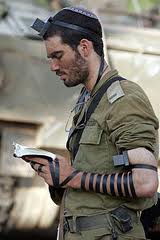The Torah commands us to commemorate the Exodus from Egypt by wearing tefillin (phylacteries) on the arm and head.
“These words will be for a sign on your arm and a reminder between your eyes, so that God’s Torah will be in your mouth; for God brought you out of Egypt with a strong arm.” (Ex. 13:9)
What is the connection between tefillin and the Exodus? How does wearing tefillin ensure that the Torah will be ‘in our mouths’?
An Outstretched Arm
Superficially, the redemption from Egypt was a one-time historical event, forging a potent memory in the collective consciousness of the Jewish people and all of humanity. But if we listen carefully to our inner soul, we will recognize that the Exodus is truly a continuous, ongoing act. The Divine miracles and signs that took place in Egypt launched the continual revelation of the hand of God, openly and publicly, on the stage of world history. The Exodus was an outburst of Divine light, potent and vibrant, in all realms of the universe, and its impact continues to resonate throughout the ages.
Before wrapping tefillin on the arm, we reflect that this mitzvah commemorates God’s “zero’a netuya,” His “outstretched arm” with which the Israelites were extracted from Egypt. What does this metaphor mean?
The word ‘arm’ (zero’a) comes from the root zera, meaning ‘seed.’ The Divine redemption of Israel in Egypt was a holy seed, planted at that point in time. That wondrous event initiated the dissemination of its message, unhindered and uninterrupted, over the generations. As we bind the tefillin to our arms, we are reminded of God’s “outstretched arm,” the inner Godliness that continually develops and perfects the world, until it elevates its treasures of life to the pinnacle of Divine fulfillment.
A Strong Arm
The Torah uses a second metaphor to describe the Exodus – the “yad chazakah,” God’s “strong arm.” This phrase indicates a second, deeper connection between the mitzvah of tefillin and the Exodus. The liberation from Egyptian bondage served to combat the debasement of life, which threatened to drown humanity in the depths of its crassness and vulgarity. Since the materialistic side of life is so compelling, it was necessary for God to reveal a “strong arm” to overcome our base nature, and allow the light of our inner holiness to shine from within. The holy act of fastening the tefillin to the arm and head helps us transform the coarse and profane aspects of life into strength and vitality, revealing an inner life beautiful in its holiness.
To triumph over humanity’s coarseness, then at its peak in the contaminated culture of Egypt, required God’s “strong arm.” We similarly need to make a strong effort so that the Torah will remain in our minds and hearts. Tefillin are called a ‘sign’ and a ‘reminder,’ for they evoke the wondrous signs and powerful miracles of our release from Egyptian slavery. We must engrave the legacy of those miracles on all aspects of life: deed, emotion, and thought. Thus we bind these memories to our hand, heart, and mind, and transform our coarse nature to a holy one. Then the Torah will naturally be “in your mouth,” in the thoughts and reflections of the heart.
Through this powerful mitzvah, engaging both the arm (our actions) and the eye (our outlook and thoughts), we continue the Divine process that God initiated in Egypt with a “strong arm.”
(Gold from the Land of Israel, pp. 118-120. Adapted from Olat Re’iyah vol. I, pp. 26-27,39)

